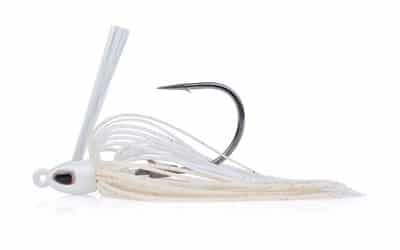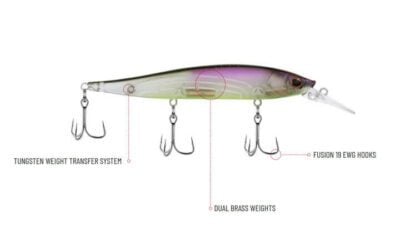A swim jig for bass is a type of fishing lure specially designed for mimicking the lively swim of baitfish, making it an effective tool in any angler’s tackle box.
Its adaptable design features a skirt and hook positioned for minimal snags, allowing it to navigate various underwater environments smoothly, enhancing your chances of landing that trophy bass. With the right choice of size, weight, and color, swim jigs thrive in clear and murky waters alike, making them indispensable for covering large areas efficiently. In this article, you’ll explore everything from jig selection to expert-endorsed techniques that enhance your bass fishing success.
Understanding Swim Jigs
 Swim jigs are not your ordinary lure; they are a powerful tool in your bass fishing arsenal. Designed for versatility and effectiveness, these jigs mimic the movement of baitfish, a natural prey for bass. Let’s dig into the key components that make the swim jig for bass a must-have for every angler.
Swim jigs are not your ordinary lure; they are a powerful tool in your bass fishing arsenal. Designed for versatility and effectiveness, these jigs mimic the movement of baitfish, a natural prey for bass. Let’s dig into the key components that make the swim jig for bass a must-have for every angler.
Swim jigs typically feature a cone-shaped or bullet-shaped head, allowing them to glide smoothly through the water. This design is essential for mimicking the natural movements of fish. The skirt, often made from silicone or rubber, is another crucial element. It pulsates with every movement, adding an irresistible lure that bass find hard to ignore. The hook’s placement is strategic, ensuring that it stays above the skirt to minimize snags when casting through weeds or rocky areas.
Customization is your best friend with swim jigs. Adding a trailer, such as a soft plastic crawfish or minnow, enhances the jig’s appeal, creating a bigger, more enticing target. The built-in weed guard is an unsung hero, offering confidence as you navigate through dense aquatic vegetation without worrying about getting snagged.
Swim jigs offer both control and creativity, giving you the freedom to adapt to changing fishing conditions.
Benefits of Using Swim Jigs for Bass Fishing
Bass anglers love swim jigs for good reason. They are the ultimate blend of adaptability and effectiveness. From clear to murky water, swim jigs have you covered.
Their versatility is key. Swim jigs excel in varied environments—whether you’re casting in calm lakes or navigating a fast-moving river. The simplicity of use is a massive bonus. You don’t have to spend hours setting up with complex rigs or additional setups. Just cast, retrieve, and watch the magic unfold. Anglers can cover large areas quickly, helping you locate bass efficiently.
Swim jigs also mimic the natural swim of a baitfish, which makes them effective even in pressured waters. Bass can’t resist their lifelike motion. This makes your lure choice a powerful ally against selective fish, eager for an easy meal.
 Selecting the Right Swim Jig
Selecting the Right Swim Jig
Choosing the right swim jig for bass is crucial for your success on the water. Here are essential factors to consider:
- Size: Match your jig to the size of local baitfish. Precision in this choice boosts your realism.
- Weight: Lighter jigs, between 1/4 oz to 3/8 oz, are perfect for shallow waters. Heavier jigs, up to 1 oz, tackle deeper or faster areas.
- Color: In clear waters, opt for natural colors. Bright hues are best for murkier waters to grab attention.
- Environmental Factors: Evaluate conditions like algae presence and adjust your jig color to maximize attraction. In shaded or dim conditions, darker jigs play to your advantage.
Remember that no single jig fits all scenarios. Adapting your setup based on these factors ensures you’re always in the game, elevating your fishing strategy and results.
Techniques for Fishing with Swim Jigs
Once your swim jig is in hand, mastering a few techniques will significantly improve your catch rates. Here’s how you can make the most of it:
- Straight Retrieve: This method involves reeling in steadily while occasionally twitching the rod tip. It creates an erratic action that bass find irresistible.
- Adjust Retrieval Speed: Gauge the bass’s activity level. Use slower retrieves in cooler waters and speed it up when it warms.
- Trailer Use: Attaching a soft plastic trailer like a curly-tail grub or paddle tail adds size and movement. This increases your jig’s effectiveness by mimicking a larger prey.
- Pause and Go: This technique simulates injured prey, enticing reaction strikes.
- Slow Roll: Navigate the jig along the bottom, akin to a bottom-dwelling creature. This is particularly effective when bass are less active.
Varying your approaches keeps your lure unpredictable, a critical factor in outsmarting wary bass. Each technique offers unique advantages and, when combined strategically, makes your swim jig an indispensable tool in your tackle box.
 Best Conditions for Using Swim Jig for Bass
Best Conditions for Using Swim Jig for Bass
Swim jigs are not only versatile but also adaptable to various fishing environments. Knowing when and where to use them is half the battle.
Swim jigs are particularly effective in clear to slightly stained waters because their lifelike movement attracts bass. They’re perfect for shallow areas, especially during spring and fall when bass are more active and surface feeding is common. Anglers will find success targeting bass near vegetation, as the design helps the jig glide through without snagging.
In addition to weedy locales, swim jigs excel in moderate to heavy cover. This allows you to confidently cast in areas that might otherwise seem daunting. When the weather is cloudy or overcast, bass are more likely to venture from cover, increasing your chances of strikes. These jigs also perform well in currents, maintaining their path without being swept away—ideal for rivers and streams.
Timing and conditions are crucial. Align your tactics with nature to maximize your chances.
Common Mistakes to Avoid
Even the best anglers can fall into some common traps when using swim jigs.
- Choosing the wrong size can disrupt the jig’s natural swim. Ensure your jig is proportionate to the local forage to maintain allure.
- Ignoring retrieval speed adjustments can lead to fewer bites. Remember, the temperature and bass activity should dictate your pace.
- Neglecting to swap trailers based on activity and conditions can decrease effectiveness.
- Before every trip, make sure your hook is sharp. Dull hooks mean missed catches.
- Mistimed hook setting can make the difference between a successful catch and a missed opportunity. Timing is everything.
Recognizing these pitfalls and preparing accordingly will keep your skills sharp and your results consistent.
Bass Species and Behavior Patterns
Understanding the specific behavior patterns of different bass species can make your swim jig endeavors more successful.
Largemouth bass often hide in cover, preferring a slow and methodical retrieve that sticks close to weed lines or structures. Faster jig retrievals appeal to the more aggressive smallmouth bass, simulating darting prey in open water. Seasonal changes also play a role. For instance, during the summer, bass often seek deeper water, making heavier jigs a practical choice.
For spotted bass, clear and deeper waters present the perfect environment for vertical jigging, offering a controlled presentation. Knowing these tendencies helps tailor your approach, maximizing bite potential.
Utilizing Expert Guides and Resources
To elevate your swim jig game, consider tapping into expert resources. Our platform, BassOnline, connects you with seasoned guides who can offer critical insights into local fishing conditions and techniques that might not be readily apparent.
Access to tutorials and visuals can significantly enhance your understanding and adaptability. Whether you’re refining your rigging techniques or learning new retrieval methods, having firsthand expert advice ensures you’re always on the cutting edge. Community forums offer another layer of support, sharing real-world experiences that can guide your next fishing adventure.
Conclusion
The swim jig for bass is more than a lure; it’s a gateway to enhanced fishing experiences. By understanding its nuances and leveraging its versatility, you’re setting yourself up for success. Each detail, from selection to technique, plays a role in amplifying your results. With continuous learning and adjustment, your time on the water becomes more productive and rewarding. Start incorporating these insights and watch your bass fishing achievements climb.






0 Comments